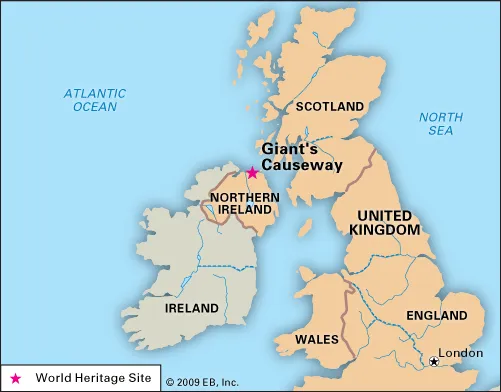The Giant's Causeway, Northern Ireland: what the footsteps of giants look like?
- GeologX

- Mar 25, 2022
- 2 min read
Updated: Mar 28, 2022
The masterpiece of a giant? Dense mists surround this bizarre staircase. Considered by legends the work of an Irish giant, the Dam consists of a series of hexagonal columns rigorously arranged and closely joined.

When the Nature transformed in mathematician, the coast of Northern Ireland became an incredible symmetry of stone - basalts, more precisely.
Symmetry could be considered something absolutely normal when met at flowers, insects or on the fur of a tiger, for example. In Geology, however, it is rare and where it appears, arouses astonishment. At Giant's Causeway, the Nature has fully demonstrated its mathematical genius, modelling tens of thousands of stone columns - caught together like a giant bundle of hexagonal pencils. For a moment, you don't know what to believe: as if it was the landscape created by computer graphics for a video game. And yet this geological wonder dates back about 60 million years, from Paleocene.
Europe and North America, then united, began to move away, pushed by Atlantic Ocean which gradually widened along a fault. Island, with its numerous active volcanos, sits nowadays exactly on this fault. Lava flows from Ireland and Scotland formed when the two continents began to move slowly.
As it flowed along the coast of Northern Ireland, lava gave rise to the largest plateau of its kind in Europe and in the world. The basalt content of the molten matter was unusually high in some places and, solidifying, it contracted (so-called thermal contraction). But the contraction forces have been so evenly distributed that the lava cracked with geometric precision. The same process occurs when the thick layer of mud from the bottom of a dried pond dries in the sun. Prismatic structures almost vertically were formed, which make you think to organ tubes.
At Giant's Causeway, the basalt columns are 46 cm diameter and their height varies between 1 and 2 m. The Dam (the geological formation) has a maximum width of 180 m, penetrates on 150 m into the sea and it consists of 40 thousands of columns.
Over the millions of years that pasts over, the glacier erosion and the continuous turbulence of the Atlantic waters sculpted the Dam to the form we see today. Each basalt column actually consists of a series of 36 cm long segments that were welded together, but then separated by internal stress. From time to time, the areas exposed are split by waves along the fracture line between the segments, giving the dam its appearance in stairs from today.
Giant's Causeway is the best known from the basaltic structures on the coast, but there are many more beyond Dam and in the gulfs from the region, with suggestive names: The Organ, The Jilt of Desires, The King and his Nobles.
The basaltic structures exist all over the world where the volcanic activity makes their formation possible and will be illustrates in beautiful photographs: Turkey, Island, Romania, Israel/Syria, India, Russia - Kuril Islands, South Korea, Vietnam, United States of America, Mexico, Australia.
Basalt hexagonal columns all over the world:
1 - Huesca de Ocampo, Mexico
2 - Fingal's Cave, Staffa, Scotland
3 - Svartifoss waterfall, Iceland
4 - Cape Stolbachaty, Kurile Islands, Russia
5 - Meshushim and the river, Israel/Syria
References:


























link link link link link link link link link link link link link link link link link link link link link link link link link link link link link link link link link link link link link link link link link link link link link link link link link link link link link link link link link link link link link link link link link link link link link link link link link link link link link link link link link link link link link link link link link link link link link link link link link link link link link link link link link link link link link link link link link link